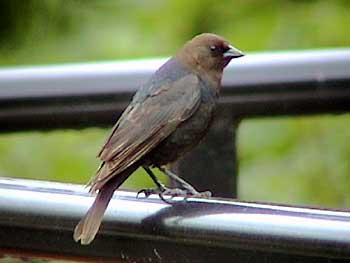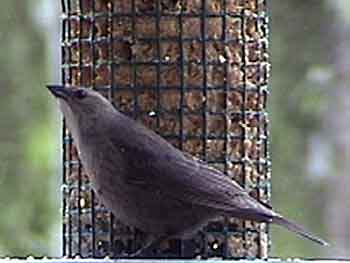Brown-headed Cowbird

Historically, cowbirds followed herds of bison and ate insects off the bison. Because they were always on the move, cowbirds laid their eggs in other birds' nests. This maneuver allowed the cowbirds to continue on their journey with the bison.
Today, cowbirds continue this process and rely on other birds to raise their young. Unfortunately for the other birds, the cowbird eggs hatch sooner and the cowbird chick is much larger than the host's chicks. The hosts feed the larger and more demanding cowbird chicks first which often lead to the demise of their own offspring.
This parasitic practice is believed to have cut the eastern woodland birds by half and even entire species of birds have nearly vanished. There are over 200 species of birds that can be the recipient of their actions with warblers and vireos usually being the unsuspected host. Cowbirds can lay as many as 80 eggs in one season.

Brown-headed Cowbirds arrive at our location around May 1. We typically see 2 males and 1 female when they arrive.
If you are interested in reading more about these birds, there is a very interesting essay entitled Cowbirds. The following is a small sample of information from this essay:
A female Brown-headed Cowbird has a long reproductive period with an extraordinarily short interval between clutches. In fact, this cowbird is the only wild passerine ever reported not to show regression of ovaries and oviducts following clutch completion. Indeed, the physiological demarcation between clutches sometimes is not at all clear, leading ornithologists to characterize female cowbirds as "passerine chickens!" Each female's laying cycle appears adapted to take advantage of a continuous supply of host nests for about a two-month period. An average female lays about 80 eggs, 40 per year for two years. About 3 percent of those 80 eggs end up as adults -- an average of 2.4 adults per female. Clearly, such numbers more than compensate for the excessive loss of eggs and young in the nests of inappropriate hosts. Each pair of cowbirds replaces itself with an average of 1.2 pairs which will double a cowbird population in eight years.
